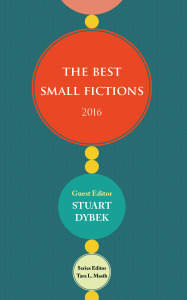Book Review
The Best Small Fictions 2016 is the latest in an ongoing conversation about the short story. The title sidesteps definitional questions—are these flash fictions, micro-fictions, sudden fictions? They’re small, the title seems to say. Let’s leave it at that. A more important question is whether these stories should be paid more attention than their longer counterparts. This collection suggests that the answer is possibly so, but not because of the suitability of small fictions to short attention spans or the hyperlinked world of clickbait; it is because they are so consistently experimental.
In keeping with last year’s inaugural publication, The Best Small Fictions 2016 draws from a variety of print and online sources. It is common to see a story built around one scene, with exposition interwoven to situate it in a wider swathe of time. As expected, the need to quickly orient the reader leads to a high proportion of declarative sentences, especially in openings. Such sentences work more diegetically than mimetically (they tell, not show). Take the opening of Amelia Gray’s one-thousand-word story, “These Are the Fables”:
We were in the parking lot of Dunkin’ Donuts in Beaumont when I told Kyle. I figured I’d rather be out under God as I announced the reason for all my illness and misery.
I said Well shit. Guess we’re having a baby.
And although the flash form can accommodate idiosyncratic characters, many small fictions make heavy use of archetypal relationships and situations. One benefit is that readers don’t have to know characters well to understand their place in a narrative. The pieces rely strongly on first person, word choice, and highly characterizing dialogue for the same reason: with limited space for action and interiority in small fiction, character must be communicated quickly.
The most noticeable trait shared by the texts is their experimentalism. The collection contains stories in triptych, in which unification is provided by metonymy (the existence of one object over time, as in “Goodbye, Piano” by Megan Giddings) or theme (fracture in “Modernism” by Paul Lisicky); multimedia stories (Charles Hansmann’s “Camouflage” intercuts prose with poetry); stories that list; and stories based on associative linking (“A Room with Many Small Beds” by Kathy Fish and “Going South” by Tina Barry). There is a bent toward magical realist premises (Elizabeth Morton’s “Parting” literalizes a “family split”). Bizarre perspectival choices are seen in “Carnivores” by Janey Skinner, written from the perspective of a Venus flytrap, and in “The Waterfall” by Alberto Chimal, told by specters that rise from the underworld during a baptism, clamoring to have their names plucked from the void. In fine, based on this collection one would assume that the short form either encourages or requires formal inventiveness.
This sense is corroborated by the micro-forms in this collection, which are perhaps the most exciting. The “giant breathless sentence” has become almost a trope of the small fiction genre. One-sentence stories take sensuous details of an already short narrative and subject it to additional syntactic compression. Extended flow without interruption creates tension, and pressure builds through a defiance of grammatical convention, much as it might in an uninterrupted film take. In “The Herald” by Eliel Lucero, a man on the train is harangued by a politically-aware public nuisance. Readers can better appreciate the man’s discomfort inside a gigantic, heaving sentence, in which the thrashing clauses remain locked in one tight grammatical cage.
Another excellent micro-fiction is the self-consciously meta-textual “The Story, Victorious.” Etgar Keret issues a Saunders-esque parody of corporate speak in a memo informing the reader of the superiority of the story which, if unappealing, “will, simply, stop.” Keret adds in a postscript (presented as a second story), “But if one day, out of nostalgia, you suddenly want the story back, it will be happy to oblige.” The parodic tone might estrange readers over a longer work, but in brief, the abutment of the first piece against a second is enough to curl the first story’s length into a miniature narrative arc.
In many ways, the effects in short fictions are not unlike those found in quantum physics: they become significant because of their small scope. The heightened effects are similar to those found in poetry. Michael Martone’s twenty-five-word story “In the Ditch, Minnesota I-35, a Biologist of the Twin Cities Ecological Field Office, Fish and Wildlife Service, Plants Milkweed, Asclepias Meadii, a Threatened Species” not only points at the productive space between work and title (often exploited by poetry), but how the gap between figurative and scientific language can be exploited to give a feeling of duration to an event that is near-instantaneous.
Which brings us back to who should read this book. The Best Small Fictions 2016 is definitional in the best sense. It relies on examples, thereby acknowledging that definition is a composite at best. It clarifies without being limiting. What the reader gets through its exemplary experiments is not a definition of flash, but a sense of some of its possibilities and peculiar virtues: in other words, a fictive space. Such an achievement is anything but small.
About the Reviewer
Kate Simonian hails from Sydney, Australia. After earning her MFA from Brooklyn College, she moved to west Texas to pursue a PhD in prose. Her work has been published by, or is forthcoming in, The Kenyon Review Online, Passages North, and The Best Australian Stories. She attends Texas Tech as a Presidential Fellow, where she's an assistant editor for Iron Horse Literary Review.
